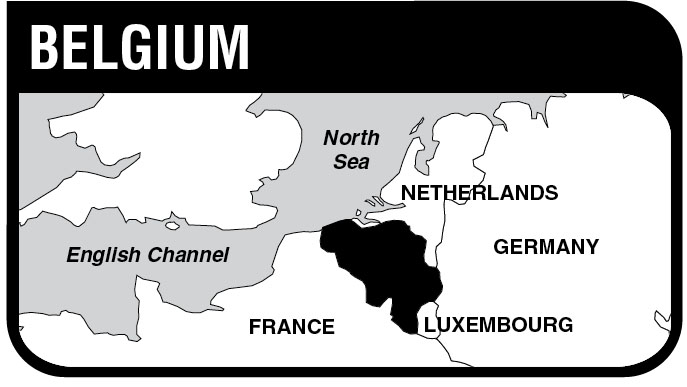

The Kingdom of Belgium, a constitutional monarchy in northwest Europe, has an area of 11,780 sq. mi. (30,519 sq. km.) and a population of 10.1 million, chiefly Dutch-speaking Flemish and French-speaking Walloons. Capital: Brussels. Agriculture, dairy farming, and the processing of raw materials for re-export are the principal industries. Beurs voor Diamant in Antwerp is the world’s largest diamond trading center. Iron and steel, machinery motor vehicles, chemicals, textile yarns and fabrics comprise the principal exports.
At the Congress of Vienna in 1815 the area was reunited with the Netherlands, but in 1830 independence was gained and the constitutional monarchy of Belgium was established. A large part of the Duchy of Luxembourg was incorporated into Belgium and the first king was Leopold I of Saxe-Coburg-Gotha. It was invaded by the German Army in August, 1914 and the German forces carried on a devastating occupation of most of the territory until the Armistice. Belgium joined the League of Nations. On May 10, 1940 it was invaded again by the German army. The Belgian and Allied forces were quickly overwhelmed and were evacuated through Dunkirk. Allied troops reached Belgium again in Sept. 1944. Prince Charles, Count of Flanders, assumed King Leopold’s responsibilities until liberation by the U.S. Army in Austria on May 8, 1945. As of January 1, 1989, Belgium became a federal kingdom.
BIBLIOGRAPHICAL NOTES: The best overview of Belgian military firearms are two books by Claude Gaier; FN 100 Years, The Story of the Great Liege Company, 1889-1989, 1989, and Four Centuries of Liege Gunmaking, 1985.
Model 1878 Officer’s Revolver (Fluted Cylinder)
This 6-shot double action centerfire revolver is chambered for the 9mm cartridge. Solid frame with fixed cylinder sliding rod ejection. Octagon barrel is 5.5 inches. Issued to Belgian officers, it is marked with the Nagant address and logo. Wooden checkered grips with lanyard loop. Weight is about 33 oz. Produced from 1878 to 1886.

Courtesy Geschichte und Technik der europaischen Militarrevolver, Journal-Verlag Schwend GmbH with permission
Exc. |
V.G. |
Good |
Fair |
1750 |
900 |
500 |
200 |
Model 1883 Revolver (Non-Fluted Cylinder)
This model was also chambered for the 9mm centerfire cartridge. Fitted with a 5.5-inch octagon barrel. Wooden checkered grips with lanyard loop. A simplified version of the Model 1878 Officer’s revolver. This model was used by NCOs, artillery, and troops in the Belgian army from 1883 to 1940.

Courtesy Geschichte und Technik der europaischen Militarrevolver, Journal-Verlag Schwend GmbH with permission
Exc. |
V.G. |
Good |
Fair |
1250 |
750 |
400 |
200 |
Model 1878/86 Officer’s Revolver (Fluted Cylinder)
This 6-shot revolver was issued to officers in the Belgian army. Chambered for the 9mm cartridge and fitted with a 5.5-inch octagon barrel. Checkered wooden grips with lanyard loop. Produced from 1886 to 1940.

Courtesy Geschichte und Technik der europaischen Militarrevolver, Journal-Verlag Schwend GmbH with permission
Exc. |
V.G. |
Good |
Fair |
1500 |
850 |
450 |
200 |
Model 1883/86 Revolver
Similar to the Model 1878/86 Officer’s but issued to NCOs as a regular sidearm. Cylinder is non-fluted. The hammer rebounds slightly after the revolver has been fired.

Courtesy Geschichte und Technik der europaischen Militarrevolver, Journal-Verlag Schwend GmbH with permission
Exc. |
V.G. |
Good |
Fair |
1250 |
750 |
400 |
250 |
A 7.65mm caliber semi-automatic pistol with a fixed barrel and a concealed hammer. Similar in appearance to the Clement. Markings with “AG” molded into the grips. Some (1,500 est.) have been found bearing German Waffenamts. Manufactured from 1930s to 1940s. Add 100 percent for German marked pistols.

Gavage 7.65mm pistol with German markings
Exc. |
V.G. |
Good |
Fair |
650 |
425 |
300 |
175 |
NOTE: For historical and technical information, see Blake Stevens, The Browning High Power Automatic Pistol, Collector Grade Publications, 1990.
Model 1900
A blowback operated semi-automatic pistol, chambered for the 7.65mm/.32 automatic cartridge. Feeds from a 7-round magazine inserted in the base of the grip. It has a 4-inch barrel and weighs 20 ounces.
The Model 1900 was the first mass produced pistol to use a slide assembly over the major operating parts in the handle. Most semi-automatic handguns made since follow that basic pattern. It was designed by John Browning in 1896. The Model 1900 was the first Browning design to be manufactured by FN and began their long running relationship with the legendary inventor. Approximately 700,000 were produced 1900-1911. The Model 1900 was not adopted by a major military force but many thousands were purchased privately for use by officers and support personnel of many nations. They are commonly found with police or military marks of Belgium, Austria, Germany, Japan and others. Such markings can add significant value for advanced collectors seeking scarcer variations.

Exc. |
V.G. |
Good |
Fair |
650 |
425 |
300 |
175 |
Model 1903
Another Browning designed blowback-operated semi-automatic, chambered for the 9mm Browning Long cartridge. This model was a moderate success and brought FN a few foreign military contracts. It is one of the largest blowback models made. The 5” barrel is held in place by five locking lugs that fit into five grooves in the frame. The finish is blued with molded plastic grips, and the detachable magazine holds 7 rounds. There is a detachable shoulder stock/holster along with a 10-round magazine that was available for this model. These accessories are extremely rare and if present would make the package worth approximately five times that of the pistol alone. There were approximately 58,000 manufactured between 1903 and 1939. This model was one of the Browning patents that the Eibar Spanish gunmakers did so love to copy because of the simplicity of the design. It should be noted that during WWI the Spanish supplied almost one million Model 1903 copies for the French army.
Production Note: FN had a number of contract sales to foreign countries from 1907 to about 1928. These countries are:
Sweden: 1907-1908 |
10,000 |
Russia: 1908-1910 |
8,200 |
Ottoman Empire: 1908-1923 |
8,000 |
England: 1914 |
100 |
Holland: 1922 |
80 |
Estonia: 1922-1928 |
4616 |
El Salvador: 1927- |
? |
Paraguay: 1927 |
324 |

Courtesy Richard M. Kumor Sr.
Exc. |
V.G. |
Good |
Fair |
850 |
650 |
450 |
250 |

Model 1910 “New Model,” Courtesy Orvel Reichert
Model 1910 “New Model”
Chambered for 7.65mm and 9mm short. It has a 3.5-inch barrel, is blued, and has molded plastic grips. The principal difference between this model and its predecessors is that the recoil spring on the Model 1910 is wrapped around the barrel. This gives the slide a more graceful tubular appearance instead of the old slab-sided look. This model has the triple safety features of the 1906 Model 2nd variation and is blued with molded plastic grips. This model was adopted by police forces around the world. It was manufactured between 1912 and 1954.
Exc. |
V.G. |
Good |
Fair |
600 |
375 |
250 |
150 |

Model 1922 • Paul Goodwin photo
Model 1922
Similar to the Model 1910, with a longer 4.5-inch barrel and correspondingly longer slide. This model was a military success, and approximately 200,000 were produced during the WWII German occupation of Belgium in 1940-1944. These pistols that bear the Waffenamt acceptance marks are known as the “Pistole Modell 626(b),” and are chambered for 7.65mm only. The Germans also had a 9mm version designated the “Pistole Modell 641(b).” These pistols would bring a 25 percent premium. There were approximately 360,000 of these pistols produced during the German occupation. There are a number of subvariations that may effect value. See listings under Netherlands and Yugoslavia for their M 1922 contract pistols. They were manufactured between 1912 and 1959.

Exc. |
V.G. |
Good |
Fair |
500 |
325 |
250 |
125 |
Model 1935
The last design from John Browning and was developed between 1925 and 1935. This pistol is known as the Model 1935, the P-35, High-Power or HP, and also as the GP (which stood for “Grand Puissance”) and was referred to by all those names at one time or another. The HP is essentially an improved version of the Colt 1911 design. The swinging link was replaced with a fixed cam, which was less prone to wear. It is chambered for the 9mm Parabellum and has a 13-round detachable magazine. The only drawback to the design is that the trigger pull is not as fine as that of the 1911, as there is a transfer bar instead of a stirrup arrangement. This is necessary due to the increased magazine capacity resulting in a thicker grip. The barrel is 4.75 inches in length. It has an external hammer with a manual and a magazine safety, was available with various finishes and sight options, and was furnished with a shoulder stock. The Model 1935 was used by many countries as their service pistol; as such there are many variations. We list these versions and their approximate values. There are books available specializing in this model, and it would be beneficial to gain as much knowledge as possible if one contemplates acquisition of this fine and highly collectible pistol.
Prewar Commercial Model
Found with either a fixed sight or a sliding tangent rear sight and is slotted for a detachable shoulder stock. It was manufactured from 1935 until 1940. Wood holster stock, add 100 percent.
Fixed Sight Version
Exc. |
V.G. |
Good |
Fair |
900 |
725 |
500 |
375 |
Tangent Sight Version
Exc. |
V.G. |
Good |
Fair |
1100 |
850 |
700 |
550 |
Prewar & WWII Military Contract
The Model 1935 was adopted by many countries as a service pistol, and some of them are as follows:
Belgium
Exc. |
V.G. |
Good |
Fair |
1750 |
1100 |
800 |
300 |
Canada and China
(See John Inglis & Company)
Denmark (See Denmark)
Great Britain
Exc. |
V.G. |
Good |
Fair |
1200 |
1000 |
850 |
550 |
Estonia
Exc. |
V.G. |
Good |
Fair |
1750 |
1250 |
900 |
600 |
Holland
Exc. |
V.G. |
Good |
Fair |
1750 |
1100 |
950 |
650 |
Latvia
Exc. |
V.G. |
Good |
Fair |
2000 |
1500 |
1050 |
775 |
Lithuania
Exc. |
V.G. |
Good |
Fair |
2000 |
1500 |
1000 |
650 |
Romania
Exc. |
V.G. |
Good |
Fair |
1800 |
1350 |
1050 |
775 |
German Military Pistole Modell 640(b)
In 1940 Germany occupied Belgium and took over the FN plant. The production of the Model 1935 continued, with Germany taking the output. The FN plant was assigned the production code “ch,” and many thousands were produced. The finish on these Nazi guns runs from as fine, as the Prewar Commercial series, to downright crude, and it is possible to see how the war was progressing for Germany by the finish on their weapons. One must be cautious with some of these guns, as there have been fakes noted with their backstraps cut for shoulder stocks, producing what would appear to be a more expensive variation. Individual appraisal should be secured if any doubt exists.

Paul Goodwin photo

Fixed Sight Model
Exc. |
V.G. |
Good |
Fair |
950 |
700 |
500 |
300 |

Courtesy Orvel Reichert

Courtesy Orvel Reichert
Tangent Sight Model
50,000 manufactured.
Exc. |
V.G. |
Good |
Fair |
1200 |
900 |
750 |
550 |
Captured Prewar Commercial Model
These pistols were taken over when the plant was occupied. They are slotted for stocks and have tangent sights. There were few produced between serial number 48,000 and 52,000. All noted have the “WaA613” Nazi proof mark. Beware of fakes!
Exc. |
V.G. |
Good |
Fair |
1800 |
1400 |
1150 |
750 |
Nazi Holster for FN 1935 Pistol
Leather construction. Brown or black color. German codes and dated on back. Some are not marked. Price range: 300 – 150.
Postwar Military Contract
Manufactured from 1946, and they embody some design changes—such as improved heat treating and barrel locking. Pistols produced after 1950 do not have barrels that can interchange with the earlier model pistols. The earliest models have an “A” prefix on the serial number and do not have the magazine safety. These pistols were produced for many countries, and there were many thousands manufactured.

Nazi Holster for FN 1935 Pistol

FN 1935 magazines, split base (l) and solid base (r) • Price 75-40; with Nazi markings 150-90
Fixed Sight
Exc. |
V.G. |
Good |
Fair |
700 |
500 |
400 |
300 |
Tangent Sight
Exc. |
V.G. |
Good |
Fair |
750 |
675 |
575 |
400 |
Slotted and Tangent Sight
Exc. |
V.G. |
Good |
Fair |
1500 |
1250 |
750 |
500 |
Sultan of Oman
This is the only post war Hi-Power that is designated a Curio and Relic pistol. It has a tangent sight. The grip is slotted to accept a shoulder stock which is a legal accessory to this model. Fewer than 50 of these pistols were brought into the U.S. These were from a canceled contract for Oman. Very rare.
NIB |
Exc. |
V.G. |
Good |
Fair |
6000 |
5750 |
4500 |
N/A |
N/A |
NOTE: For pistols with no shoulder stock deduct $1,000.
Prior to 1940, Belgium used the MP28 (Model 34) as its standard military submachine gun. FN also manufactured, under license from Israeli Military Industries (IMI), a copy of the UZI submachine gun.
Vigneron M2
This subgun was issued to the Belgian army in 1953. It was also used by those same forces in the Belgian Congo. Many of these guns were taken by Congo forces after independence. A number of Vigneron guns may be found over much of Central Africa. The gun is chambered for the 9mm cartridge and has a wire folding stock. Barrel length is 11.75 inches with the rear portion of the barrel finned. A muzzle compensator is also standard. Magazine capacity is 32 rounds. Rate of fire is about 600 rounds per minute. Capable of select fire. Markings are found on the right side of the magazine housing and read, “ABL52 VIG M1.” Also on the right side of the receiver is stamped “LICENCE VIGNERON.” Weight is about 7.25 lbs. The gun was in production from 1952 to 1962.
Pre-1968
Exc. |
V.G. |
Fair |
15000 |
12500 |
10000 |
Belgian Pre-Cartridge Era Rifles
Leige, Belgium was an early arms manufacturing center. Numerous models were produced at several factories. Many were copies of English or French patterns. They were exported all around the globe. Belgian made rifles were the most prolific foreign made arm imported to North America by both sides of the U.S. Civil War. There are far too many contracts and variations to list here. Below is an example of the typical Belgian import.



Belgian Model 1842 Percussian Rifle

Albini-Broendlin Model 1867
Belgian Model 1842 Percussian Rifle
Caliber 69; 40.5-inch barrel. A copy of the French Mle 1842 rifle. The example shown was made by A. Francotte. Add 10-25% for a U.S. Civil War example. Add 100+% for Confederate examples. Beware of fakes.
Exc. |
V.G. |
Good |
Fair |
Poor |
800 |
650 |
450 |
250 |
150 |
Albini-Broendlin Model 1867
A breech loading conversion of earlier Belgian issue rifles. Models include the M1841/67 and the 1853/67. A new 32-inch barrel was installed. Caliber is 11×50Rmm. Utilizes a front hinged lifting breechblock similar to the U.S. Trapdoor series.
Exc. |
V.G. |
Good |
Fair |
1500 |
950 |
700 |
300 |
Model 1889 Rifle
The Mauser rifle that Fabrique Nationale was incorporated to manufacture. It is chambered for 7.65mm and has a 30.5-inch barrel. The magazine holds 5 rounds. The unique feature that sets the Belgian rifle apart from the Mausers made by other countries is the thin steel tube that encases the barrel. This was the first Mauser to use a charger loaded detachable box magazine. The sights are of the military type. The finish is blued, with a walnut stock. This rifle was also made by the American firm of Hopkins and Allen (rare).
Exc. |
V.G. |
Good |
Fair |
800 |
650 |
400 |
250 |
NOTE: For the Hopkins and Allen examples, add a premium of 100 percent.

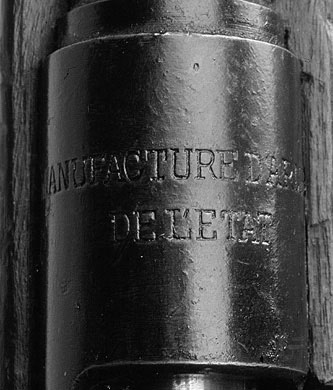
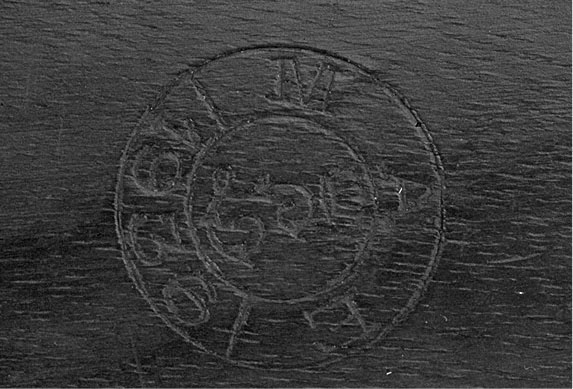
Belgian Model 1889/36 Short Rifle • Courtesy West Point Museum, Paul Goodwin photo
Bayonets for Model 1889 Mauser
Wood grips. Muzzle ring. Hook quillon. These were made in long and short single edge blade styles. The appearance of the long version is similar to the Argentine 1909 bayonet. Long model might be marked “Hopkins & Allen” on the ricasso. Steel scabbard. Price range 250 – 100. Add 100 percent for H&A marked examples.
M1889 Carbine
Barrel length is 21 inches. Fitted for a bayonet. Weight is about 7.5 lbs.
Exc. |
V.G. |
Good |
Fair |
800 |
550 |
400 |
200 |
M1889 Carbine Lightened
Fitted with a 15.75-inch barrel and turned down bolt. A slotted sling bracket mounted on left side of buttstock.
Exc. |
V.G. |
Good |
Fair |
750 |
550 |
400 |
200 |
M1889 Carbine Lightened
Same as above but with longer stock. A unique bayonet, handle has no guard and frequently having a double curved blade, was also issued with this carbine. No examples of this bayonet could be found to list here.
Exc. |
V.G. |
Good |
Fair |
750 |
550 |
350 |
200 |
M1890 Turkish Rifle
Captured Turkish Model 1890 rifles with Belgian rear sight similar to the Model 1889 rifle. No handguard. Original Turkish markings remain. Belgian proofs.
Exc. |
V.G. |
Good |
Fair |
750 |
550 |
375 |
250 |
M1916 Carbine
Similar to the Model 1889 but with different bracket on buttstock.
Exc. |
V.G. |
Good |
Fair |
750 |
500 |
350 |
150 |
M1935 Short Rifle
This model is very similar to the German Kar 98k and uses the M98 bolt system. It is fitted with a 5-round flush magazine. Chambered for 7.65mm Mauser cartridge. Barrel length is 23.5 inches. Weight is about 9 lbs.
Exc. |
V.G. |
Good |
Fair |
750 |
600 |
450 |
250 |
M1889/36 Short Rifle
This model is a converted Model 1889 with a 23.5-inch barrel with wooden handguard. The upper barrel band and front sight are of the Model 1935 type. The bolt system appears similar to the Model 98. Chambered for the 7.65mm Mauser cartridge. Weight is about 9 lbs.
Exc. |
V.G. |
Good |
Fair |
575 |
475 |
350 |
150 |
Belgian M1916/24 Bayonet for Mausers
Belgium used a variety of bayonets of the patten shown. Wood grips. Muzzle ring. The common infantry version shown has a 17.6-inch double edge blade. The Gendarmerie version has a single edge T-shaped blade. There are also versions with shortened blade lengths of 12.3 inches – 13.8 inches. Price range 225 – 100.
M50 Short Rifle
Post war surplus rifle converted to .30-06 caliber. Barrel length is 23.2 inches. Tangent leaf rear sight graduated to 2000 meters. Marked “B/ABL/[DATE].” Weight is approximately 9 lbs.
Exc. |
V.G. |
Good |
Fair |
800 |
500 |
350 |
225 |
M35/46 Short Rifle
Similar to the M50 short rifle.
Exc. |
V.G. |
Good |
Fair |
800 |
500 |
350 |
175 |
M24/30 .22 Caliber Training Rifle–Army
This is a military training rifle in .22 caliber built for the Belgian army after WWII.
Exc. |
V.G. |
Good |
Fair |
850 |
600 |
450 |
275 |
M24/30 .22 Caliber Training Rifle–Navy
Same as above but for the Belgian navy.
Exc. |
V.G. |
Good |
Fair |
850 |
600 |
450 |
300 |

Belgian M1916/24 Bayonet for Mausers

Model 30 Postwar Short Rifle • Courtesy Daniel Rewers Collection, Paul Goodwin photo
FN M30 Postwar Short Rifle (M24/30, M35/46)
Built after WWII for the Belgian army. It uses the standard M98 action. Converted from Model 1935 rifle to .30-06 caliber. Barrel length is 23.3". Weight is about 9 lbs. Magazine capacity is 5-round in an integral box.
Exc. |
V.G. |
Good |
Fair |
850 |
550 |
300 |
175 |
Model 1924/30 Export Bayonets for Mausers
Wood handle. Muzzle ring. 15- or 9.5-inch single edge blade. No markings except possibly a serial number on the end of the pommel. Sold with the M1924 Mauser rifles to many nations. Price range 80 – 40.
Model 1949 or SAFN 49
A gas-operated semi-automatic rifle chambered for 7×57, 7.92mm, and .30-06. It has a 23" barrel and military-type sights. The fixed magazine holds 10 rounds. The finish is blued, and the stock is walnut. This is a well-made gun that was actually designed before WWII. When the Germans were in the process of taking over Belgium, a group of FN engineers fled to England and took the plans for this rifle with them, preventing the German military from acquiring a very fine weapon. This model was introduced in 1949, after hostilities had ceased. This model was sold on contract to Egypt, chambered for 7.92mm; to Venezuela, chambered for 7×57; and to Argentina, Colombia, Indonesia, Belgium, and Luxembourg chambered for the .30-06. Argentina models were chambered for the 7.65×53mm as well as the Argentina navy which had its rifles chambered for the 7.62 NATO cartridge. The FN 1949 bears serial numbers on the receiver, top cover, bolt and bolt carrier. Deduct 25 percent for any MM parts.

Courtesy Richard M. Kumor Sr.
Belgium military issue
Cal. 30-06. Receiver marked “ABL”. No Belgian issue FN 1949s have been legally imported as they have the slot in the receiver to allow installation of a select-fire trigger group. This makes it a machine gun under BATFE regulations. There might be a handful of pre-1968 imports but none could be found while preparing this edition. They would need to registered with the NFA to be legal.
Exc. |
V.G. |
Good |
Fair |
18000+ |
N/A |
N/A |
N/A |
Columbian contract
Cal. 30-06. Receiver marked with Columbian crest.
Exc. |
V.G. |
Good |
Fair |
1250 |
900 |
700 |
400 |
Luxembourg contract
Cal. 30-06. Receiver marked “AL”.
Exc. |
V.G. |
Good |
Fair |
1200 |
900 |
700 |
400 |
Egyptian contract: See Egypt.
Venezuelan contract
Cal. 7×57mm. Receiver marked with Venezuelan crest. The only FN-49 that was issued with a flash hider.
Exc. |
V.G. |
Good |
Fair |
950 |
700 |
550 |
300 |
Argentine contract: See Argentina.
Bayonet for FN Model 1949, Type 1
Wood grips. 9-1/4 inch double edge blade. National versions have slightly different marks. The Belgian is marked “SA .30” and is numbered on the pommel and the scabbard. The Egyptian has Farsi numbers on the end of the handle. Some versions have no markings at all. Pricing is the same. Price range 95 – 50.

Bayonet for FN Model 1949, Type 1

Bayonet for FN Model 1949, Type 2
Bayonet for FN Model 1949, Type 2
This bayonet was made for the Venezuelan 7mm rifle. Wood grips. 15 inch single edge blade. This is the same as the FN Model 1924 long export bayonet that has the muzzle ring enlarged to .715 inch to fit over the flash hider on the FN 1949. The only marking is a serial number on the end of the pommel. Price range 90 – 50.
Model 30-11 Sniper Rifle
Chambered for the 7.62 NATO cartridge. It has a 20-inch heavy barrel and Anschutz sights. There is a flash suppressor mounted on the muzzle. It is built on a highly precision-made Mauser bolt action fed by a 9-round, detachable box magazine. The walnut stock is rather unique in that the butt is made up of two parts, with the rear half being replaceable to suit the needs of different-sized shooters. It is issued with a shooting sling, bipod, and a foam-lined carrying case. This is a rare firearm on the commercial market as it was designed and sold to the military and police markets.
Exc. |
V.G. |
Good |
Fair |
5000 |
4500 |
N/A |
N/A |
FN-FAL
A gas-operated, semi-automatic version of the famous FN battle rifle. This weapon has been adopted by more free world countries than any other rifle. It is chambered for the 7.62 NATO or .308 and has a 21" barrel with an integral flash suppressor. The sights are adjustable with an aperture rear, and the detachable box magazine holds 20 rounds. The stock and forearm are made of wood or a black synthetic. This model has been discontinued by the company and is no longer manufactured.

Courtesy Jim Supica, Old Town Station
The models listed below are for the metric pattern Type 2 and Type 3 receivers, those marked “FN MATCH.” The models below are for semi-automatic rifles only. FN-FAL rifles in the “inch” pattern are found in the British Commonwealth countries of Australia, India, Canada, and of course, Great Britain. These rifles are covered separately under their own country headings.
50.00–21" Rifle Model
NIB |
Exc. |
V.G. |
Good |
Fair |
5000 |
3000 |
2500 |
2000 |
N/A |
50.63–18" Paratrooper Model
NIB |
Exc. |
V.G. |
Good |
Fair |
5000 |
3500 |
3000 |
2750 |
N/A |
50.64–21" Paratrooper Model
NIB |
Exc. |
V.G. |
Good |
Fair |
4000 |
3500 |
3000 |
2750 |
N/A |
50.41–Synthetic Butt H-Bar
NIB |
Exc. |
V.G. |
Good |
Fair |
3250 |
2800 |
2500 |
2000 |
N/A |
50.42–Wood Butt H-Bar
NIB |
Exc. |
V.G. |
Good |
Fair |
4000 |
3500 |
3000 |
2750 |
N/A |
NOTE: There are a number of U.S. companies that built FN-FAL receivers and use military surplus parts. These rifles have only limited collector value as of yet.

18" Para Model • Courtesy Blake Stevens, from The FAL Rifle

21" Para Model • Courtesy Blake Stevens, from The FAL Rifle
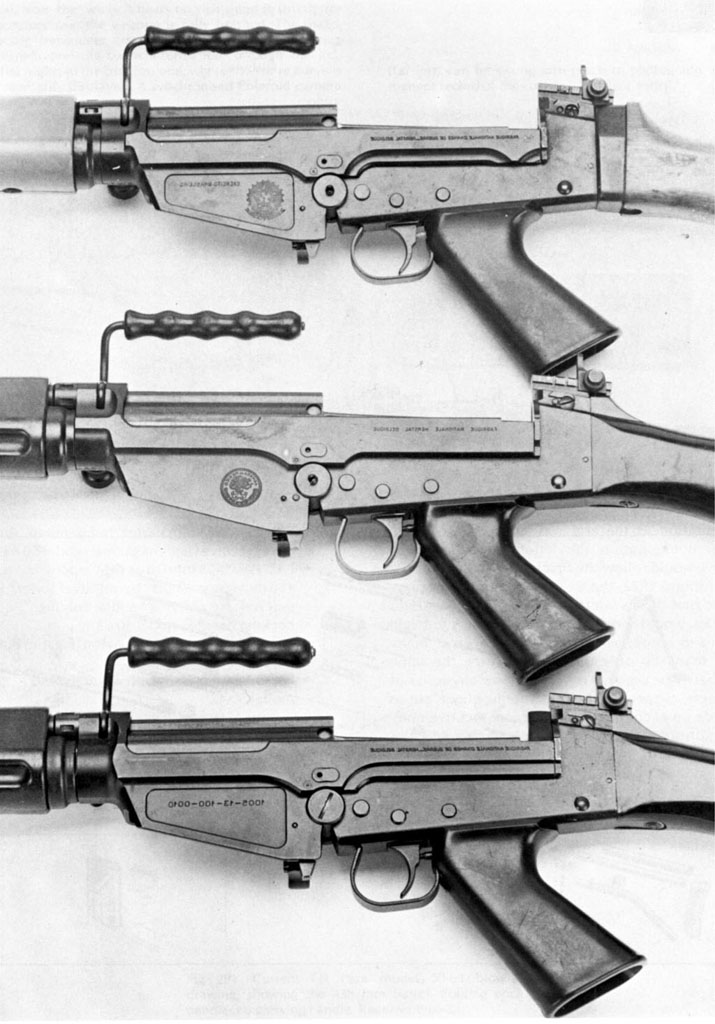
FAL Receivers: Top - Type 2; Middle - Type 3; Bottom - Type 1 • Courtesy Blake Stevens
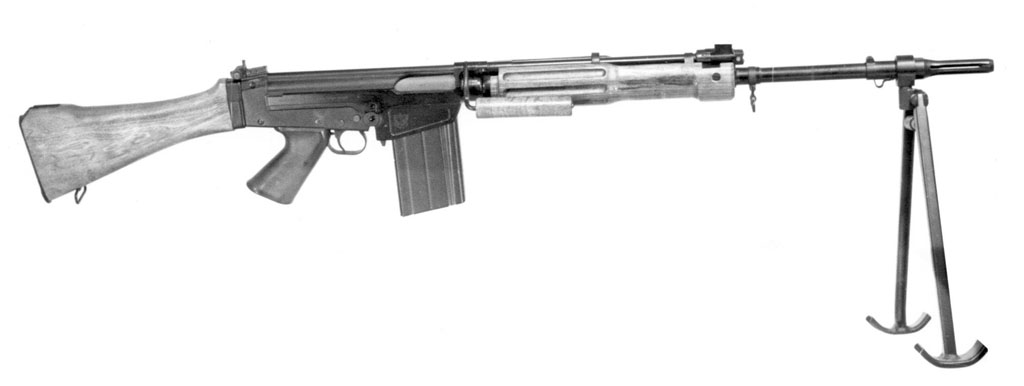
FN Heavy Barrel Model • Courtesy Blake Stevens, from The FAL Rifle

Courtesy FN
FN FAL “G” Series (Type 1 Receiver)
The first FAL to be imported to the U.S. The receivers are capable of accepting select-fire parts. These rifles are subject to interpretation by the BATF as to their legal status. A list of BATF legal serial numbers is available. This information should be referenced prior to a purchase. There were 1,848 legal “G” Series FN FAL rifles imported into this country. All were “grandfathered” and remain legal to posess.
Standard
NIB |
Exc. |
V.G. |
Good |
Fair |
7500 |
6500 |
5000 |
3000 |
N/A |
Lightweight
NIB |
Exc. |
V.G. |
Good |
Fair |
7500 |
6500 |
5000 |
3000 |
N/A |
FN FAL–Select Fire Assault Rifle
First produced in 1953, this 7.62×51mm select fire rifle has been used worldwide. It is fitted with a 20.8-inch barrel and a magazine that holds 20 rounds. It is available in several different configurations. Weight is about 9.8 lbs. Marked “FABRIQUE NATIONALE HERSTAL.” Markings will also indicate many other countries made this rifle under license from FN.
Pre-1968 (Rare)
Exc. |
V.G. |
Fair |
18500 |
15000 |
12000 |
Pre-1986 full-auto conversions of semi-automatic model
Exc. |
V.G. |
Fair |
15000 |
12500 |
10000 |
Bayonets for FN FAL
There are two primary patterns for this rifle. Many were exported along with the FAL rifles. Type 1 has wood, metal or plastic grips. Muzzle ring with flash hider prongs. 7.75" single edge blade. Steel scabbard. Price range 60 – 25. Type 2 has a tubular handle that fits over the flash hider. 6.3" double edge blade. Steel or plastic scabbard. Price range 60 – 25.


Bayonets for FN FAL

FN CAL-Select Fire Assault Rifle • Courtesy private NFA collection
FN CAL
Chambered for the 5.56×45mm cartridge and designed with a rotary bolt. It is fitted with an 18.2-inch barrel and has a magazine capacity of 20 or 30 rounds. Weight is about 6 lbs. With folding stock. Produced from 1966 to 1975 and is marked “FABRIQUE NATIONALE HERSTAL MOD CAL 5.56MM” on the left side of the receiver. This rifle was not widely adopted. A rare rifle. Only about 20 of these rifles were imported into the U.S.
NIB |
Exc. |
V.G. |
Good |
Fair |
7000 |
6500 |
5000 |
3000 |
N/A |
FN CAL-Select Fire Assault Rifle
Chambered for the 5.56×45mm cartridge and designed with a rotary bolt. It is fitted with an 18.2-inch barrel and has a magazine capacity of 20 or 30 rounds. Its rate of fire is 650 rounds per minute. Weight is about 6 lbs. With folding stock. Produced from 1966 to 1975 and is marked “FABRIQUE NATIONALE HERSTAL MOD CAL 5.56MM” on the left side of the receiver. This rifle was not widely adopted.
Pre-1968 (Rare)
Exc. |
V.G. |
Fair |
15000 |
12500 |
10000 |
FNC
A lighter-weight assault-type rifle chambered for the 5.56mm cartridge. It is a gas-operated semi-automatic with an 18- or 21-inch barrel. It has a 30-round box magazine and is black, with either a fixed or folding stock. This model was also discontinued by FN.
Standard
Fixed stock, 16- or 18-inch barrel.
NIB |
Exc. |
V.G. |
Good |
Fair |
3800 |
3500 |
2750 |
2000 |
N/A |
Paratrooper Model
Folding stock, 16- or 18-inch barrel.
NIB |
Exc. |
V.G. |
Good |
Fair |
3800 |
3500 |
2750 |
2000 |
N/A |
NOTE: The above prices are for Belgian-made guns only.
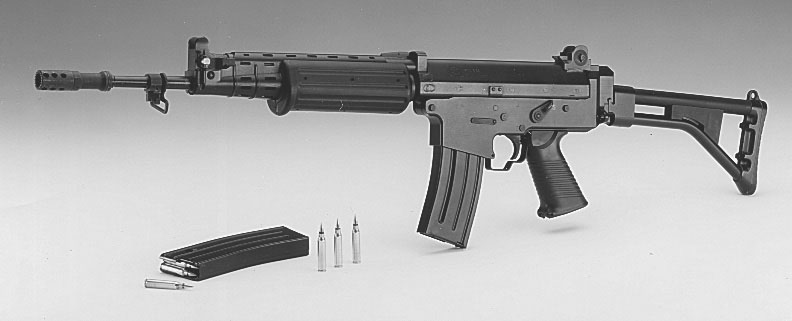
FN FNC–Select Fire Assault Rifle
This model, introduced in 1979, took the place of the CAL. Chambered for the 5.56×45mm cartridge and fitted with a 17.5-inch barrel, it weighs about 8.4 lbs. It has a 30-round magazine capacity. Rate of fire is 700 rounds per minute. Fitted with a metal folding stock. This model will accept M16 magazines. Marked “FNC 5.56” on left side of receiver. This rifle was adopted by the Belgian, Indonesian, and Swedish militaries.
Pre-1986 full-auto conversions of semi-automatic model
Exc. |
V.G. |
Fair |
8000 |
6000 |
4500 |
FN BAR Model D (Demontable)
This was the FN version of the Browning automatic rifle. It is fitted with a quick change barrel and pistol grip. It was offered in a variety of calibers from 6.5 Swedish Mauser to the 7.92×57mm Mauser. It is fitted with a 19.5-inch barrel and has a rate of fire of either 450 or 650 rounds per minute. Weight is about 20 lbs. Marked “FABRIQUE NATIONALE D’ARMES DE GUERRE HERSTAL-BELGIQUE” on left side of receiver.
FN sold about 700 Model Ds to Finland in 1940 which the Finns used during their “Winter War” with the Russians. These Finnish BARs were chambered for the 7.63×54R cartridge. Also a small number of FN guns were sold to China (2,000) and Ethiopia in the 1930s. These BARs were chambered for the 7.92×57mm Mauser cartridge. After World War II FN sold its Model 30 BAR to a number of countries around the world.

Courtesy Jim Thompson
Pre-1968 (Very Rare)
Exc. |
V.G. |
Fair |
37500 |
32500 |
27500 |
Pre-1986 manufacture with new receiver or re-weld
Exc. |
V.G. |
Fair |
25000 |
20000 |
18000 |
Fabrique Nationale has a long history of manufacturing John M. Browning’s firearms. These firearms include the Browning Model 1917, M1919, and .50 caliber heavy gun. The light machine guns were chambered in a variety of calibers and sold around the world by FN. During WWII the FN factory was occupied by German troops, but after the war in 1945 when production finally returned to normal levels, the Belgians produced the air-cooled Browning guns in 7.62×63mm (.30-06) for the Belgian army. When NATO adopted the 7.62×51mm cartridge, FN designed and built the FN MAG machine gun.
FN MAG (Mitrailleuse d’Appui Generale) (M240)
First produced in Belgium in 1955, this machine gun is chambered for the 7.62×51mm cartridge. It is fitted with a 21.3-inch quick change barrel and has an adjustable rate of fire of 700 to 1000 rounds per minute. It is belt-fed with metal links. The basic configuration uses a wooden buttstock, smooth barrel with bipod attached to gas cylinder, pistol grip, and slotted flash hider. The gun can also be attached to a tripod as well as used with an anti-aircraft mount. Weight is about 22 lbs. Marked “FABRIQUE NATIONALE D’ARMES DE GUERRE HERSTAL BELGIUM” on the right side of the receiver. This gun is still in production and is in use by over 80 countries worldwide.
There is an aircraft version of this gun designated as Model 60-30 (single mount) or 60-40 (twin mount). The gun can also be mounted in a coaxial configuration such as a tank or armored vehicle.



FN MAG (Mitrailleuse d’Appui Generale) (M240) • Courtesy Amoskeag Auction Company
Pre-1968 (Very Rare)
Exc. |
V.G. |
Fair |
125000+ |
— |
— |
Pre-1986 conversions
Side-plates, 65 registered.
Exc. |
V.G. |
Fair |
80000 |
75000 |
67500 |
NOTE: This is an extremely rare machine gun with prices based on scarcity and demand. It is possible for prices to exceed $125,000 under certain conditions.
FN Minimi (M249)
Designed as a squad automatic weapon (SAW) and chambered for the 5.56×45mm cartridge, this machine gun has a rate of fire of 700 to 1,000 rounds per minute and is equipped with a 30-round box magazine or 100- to 200-round boxed belts. Rate of fire with box magazine is higher than when using belt. The quick change barrel length is 18" and weight is about 15 lbs. Marked “fn minimi 5.56” on the left side of the receiver. First produced in 1982, this gun is called the M249 machine gun in the U.S. Army. It is also in service in a number of other countries such as Canada, Australia, and Italy.

Courtesy private NFA collection
Pre-1986 transferable
Extremely rare, 1 known.
Exc. |
V.G. |
Fair |
150000+ |
— |
— |